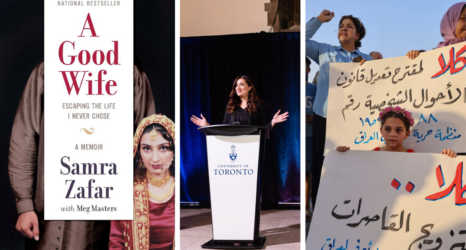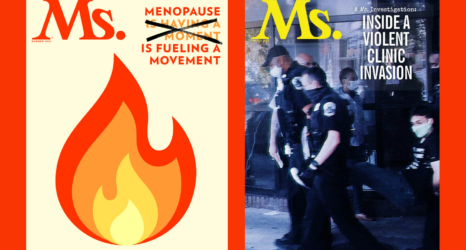In her debut memoir, I’ve Had One Too: A Story of Abortion and Healing, author Anna Wood demystifies what abortion can look like. Moving beyond the stark binaries of pro-choice and pro-life, she brings readers along her personal journey to come to terms with her decision to have an abortion. Wood weaves together a deeply personal journey of pregnancy and abortion with the societal level issues of racial and economic inequality that are at the root of the ongoing fight for reproductive justice. A story of both self-acceptance and increased awareness of the challenges faced by any child who is born into today’s world—Wood also shows us that it’s time to look beyond the binary thinking of pro-life/pro-choice, to the individual factors that color all of our abortion stories.
You can read an excerpt from her book here.
Below is a conversation between abortion access activist and Ms. contributor Steph Black and author Anna Wood.
Steph Black: One thing that really struck me in your book was your unpacking of this idea of “I’m pro-choice but I would never have an abortion myself.” Why is that mentality so harmful?
Anna Wood: Broadly speaking, it’s really “othering” of women who’ve had an abortion. You can hide behind it because you can say, “Oh, I’m pro-choice” but it’s still putting women in that camp of “other.” Having been on both sides of that claim, I didn’t realize I was doing that. It’s a way of still drawing a line between us and them and good girls who don’t have abortions.
Black: Well said. As an activist myself, I’ve never had an abortion, but I say, “I support women who have an abortion period,” or “I support anyone who wishes to have one.” We don’t need that extra commentary.
Wood: Exactly, exactly. You don’t have to caveat that with anything.
Black: Right. This brings me to the next question: Throughout your book you describe your loved ones, one of whom is conservative. You were shocked to learn of her abortion. What is the lesson you learned from that conversation?
Wood: People in your life have had abortions. You might not know it but this has happened to them. By the age of 45, one in four women will have an abortion. That’s a lot! If you look around your group of friends, somebody in your group has had an abortion—but because it’s so stigmatized we don’t talk about it. We can’t come to the conclusion, “These people definitely don’t know anything about abortion.” People have things going on in their lives that you don’t know, whether it’s abortion or other reproductive issues. One of the biggest things coming out of this is I’m so much less judgmental. I don’t assume that I know everything that’s going on with someone.
Black: This is the question I struggle with and so, a little bit selfishly, I am very curious about where you think men fit into this equation. You broadened my perspective a lot about the fact that men do experience abortion. In their own way for sure, but they do experience abortion.
How can the pro-choice movement support those men who are mourning a wanted pregnancy, for example, and what does good allyship look like from men in general?
Wood: My ex had an opinion. I absolutely respected his opinion and this choice impacts him as well. It’s important for them to be allowed to have their voice heard and have open conversations about it. However, I wasn’t in a physically dangerous situation where somebody was going to physically harm me, which is different. In my case, I really respected that he was brave enough to say, “This pregnancy doesn’t work for me in my life right now.”
After the abortion, one thing that neither of us recognized was that he needed space to grieve himself. However, especially because he didn’t want to continue the pregnancy, I assumed that he was fine afterward. He didn’t express himself well.
Black: You describe in detail the vulnerability and hormone swings and the grief you experienced after your abortion. These things aren’t always talked about on the pro-choice side and certainly, some people have a very easy time deciding to have an abortion and don’t really have to think twice. I think there’s also this mentality of, “We don’t want to air our ‘dirty laundry’ to the antis who then use that grief or hesitancy as fodder.”
Reading your book was very important for me to be able to hold that nuance. What do you wish that other pro-choice and pro-abortion activists like myself knew about how to hold space for people who are struggling with their decision and the aftermath of their abortion, and what can we do to better support women to the entirety of their abortion?
Wood: You hit on a piece of it that I hadn’t considered. The way we talk about abortion can be so binary. Either you fall into this camp of “NBD,” doesn’t matter, whatever—or on the other side, you’re guilty and ashamed. That’s something anti-choice people will latch on to and be like, “Well, you’re guilty because it’s a bad moral decision.” But there can be some gray areas. It can be both the right decision and an emotional decision and there’s legitimacy to both.
Another solution is having clinics offer whole reproductive care, that offers services from puberty to menopause. I’ve heard of clinics like this in California and New York. When you hit puberty you can come in for annual exams and check-ups, or if you’re pregnant you can get OB-GYN care and if you want an abortion, you can go there too. I only had one check-up after my abortion and it was to do an ultrasound to make sure the abortion was complete. But I never got a phone call that asked me how I was doing emotionally, even though I was given a list of therapists. Don’t get me wrong, my clinic was great, but I would have loved that phone call asking me how I was doing.
“[Abortion] can be both the right decision and an emotional decision, and there’s legitimacy to both.”
Black: It’s so interesting you say that because that is now slowly but surely happening more with women who are postpartum and getting checkups to look for things like postpartum anxiety and depression. If clinics and providers are offering that service to somebody who’s given birth, they should offer that to somebody who’s had an abortion and have that really holistic birth AND abortion care, physical AND emotional health checks.
Wood: I read an article the other day that New Zealand is offering leave for miscarriages. It drives me nuts that in our society that it’s like, “We don’t want you to have any abortion access, but also, nobody’s going to help you with all the kids you have already” or any other fertility struggles you’re experiencing. And it’s like, how is this supposed to work?
Black: It’s totally illogical. It’s a good point to drive home, that we can’t have the abortion but if you have kids we can’t give you any help either. It’s a no-win situation.
Wood: Another thing too, looking at your website and your work I wanted to bring this up. At the clinic I went to there were no protesters. To be honest, it didn’t even occur to me that there could be. Had there been, I don’t know what I would have done when I showed up. I can’t imagine what that would be like, to walk through protesters and I appreciate so much the work that you do as a clinic escort and defender.
Black: Thank you. Now that you mentioned that I had that thought when I was reading your book when you describe crying outside of the clinic with your partner. I had that moment of wondering how many people approached her or harassed her or made false assumptions about her. I wondered how anti-choice protesters outside our local clinics would have interpreted that. I feel very lucky for you and grateful that there were no protesters there because I can’t even imagine being in that fragile state and having somebody either telling you to save your baby or call you a whore and a sinner, which unfortunately is a common occurrence outside of clinics.
Wood: I don’t know how I would have handled it. In the book, “Shrill” by Lindy West, there’s a chapter called Lemons and it’s about her abortion. She talks about how she went to her ob-gyn when she knew she wanted to have an abortion and they told her she had to go to a clinic and was baffled—like isn’t this something that doctors do?
Black: Well, it’s funny you say that because when the FDA, put mifepristone on the market in 2000 or 2001, it was for physicians to be able to just prescribe it to people who came in for a normal checkup or who just wanted to talk to their family physician of many years or a PCP they’ve had forever that they trust. The idea was that doctors would casually prescribe abortion medications and that would be that.
But because of the backlash that they got from antis and politicians, these medications—that are extremely safe and effective—got shunted to external clinics that I think people don’t realize exist or that they have to go see. It’s just another barrier to care that privileges some people.
Wood: Yeah. The editor I worked with is British she’s had an abortion. My story was eye-opening to her because in England you just go to an NHS clinic anywhere. The government pays for it. Maybe there’s some stigma around it but nothing like in the U.S. I’m sure that part of abortion stigma is that it’s not your regular doctor who is providing your care.
Black: Every clinic I’ve seen is lovely and providers really appreciate their patients. There’s dignity involved. But when you put abortion in this other building, in a separate space from other medical care, it’s almost like what we talked about at the beginning of our conversation, it’s “us vs them.” Abortion is a thing that happens over there to people like them.
AW: That’s another reason this work is important. My goal is to normalize that this is what an abortion can be like and this is the kind of person who gets an abortion. If just one person can read this and be like, oh, I know that feeling! Maybe this will resonate with one person at one particular point in their life.
Up next:






